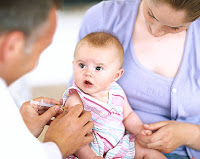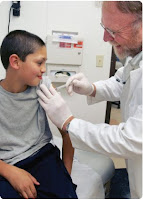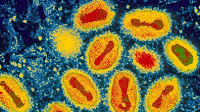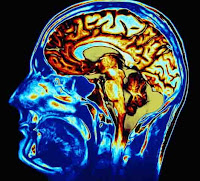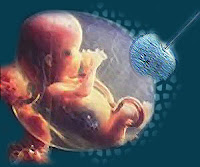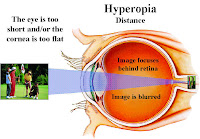Water borne disease Cholera
One of the good example of water borne disease is cholera.In the part of Asia this cholera is endemic, especially in India.From th time to time the endemic used to occurs in some other countries.As in 1992 in Peru which was one of the first out break is South America of twentieth century.More the sixteen thousand of people died over all the world wide from the half million case of cholera in 1991.But the improved and advanced treatment has decrease the death rate dramatically but this is still one of the serious disease counted.Before discovering the cholera the death rate due to it was enormous.For e.g. nearly half a million of people were killed in New York in one epidemic in 1832 A.D.
The transmissions, sign and the symptomss of cholera:-
The name of the organism that cause the cholera is comma-shaped motile bacterium which is called Vibrio cholera.The main sources to generate this disease is due to the contaminated water by faeces from sufferer of disease or the carrier.The carrier is the individual who is infected by the Vibrios & does not develop the typical symptom of cholera.Therefore it is found that only one infected person in so develop the disease , rest being the carriers.The faeces containing the Vibrios are considerable threat when carrier are free moving in the society of it is due to drinking the contaminated water or washing utensils or food in it.The direct contaminations of eating food with the faeces result the poor hygiene.
The Vibrio cholera use to multiple in intentine by releasing the one of the powerful toxin which is use to results in the violent inflammation of intestine & the production of watery diarrhoea.Especially they used to multiple in the intestine of the human but even they can survice outside of the body too.Main sign of disease is servere diarrhoea due to irritation of the bowel by toxins from Vibrios.Liquid of faeces is so cloudy & profuse that which is called the Rice water.In a single day up to 15dm3(cube) of fluid can be lost.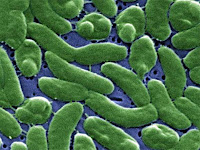 The other common sign is paining the abdominal and vomitting.The fever use to be absent, but the skin feel deathy cold & often damp.The dehydration is very fast & quick which result the death until the rehydration treatment is done.In fact the faeces are not collected or disposed of hygienically then one patient can infect a wide area of the community up to thousands millions of vibrios are contained in each cubic centimeter of diarrhoea.Therefore the mild case of cholera or a carrier may use to creat the greatest hazard as they move arounds.
The other common sign is paining the abdominal and vomitting.The fever use to be absent, but the skin feel deathy cold & often damp.The dehydration is very fast & quick which result the death until the rehydration treatment is done.In fact the faeces are not collected or disposed of hygienically then one patient can infect a wide area of the community up to thousands millions of vibrios are contained in each cubic centimeter of diarrhoea.Therefore the mild case of cholera or a carrier may use to creat the greatest hazard as they move arounds.
Treatment and prevention of cholera
Many people use to die due to the disease cholera due to the loss of water with the minerals salts, which is dehydration.Therefore the main work is to replacement of these thing.When there is epidemic then the immediate therapy is by the oral rehydration, which means the administering the pack of water which contains the sugar and balanced mineral salt.This process of replacement of water must be done from the 1.5 volume to the volume of stool losts.Fluid also can be administered by the drip feed into the veins.
Different types of antibiotics can be used for destroying the vibrios & decreasing diarrhoea such as tetracycline & chloramphenicol.The chloramphenicol is one of the most effective against the tetracycline resistants vibrios.
While devasting the epidemic is London in 1849A.D a physican called the John Snow had demonstrate the cholera is transmitted by the way of water by removing handle of Broad Streed pump which is nowBroadwick Street.This was only one water supply for the poor slum community who were very badly affected by the cholera.Local epidemic was cease.The Authorities were not convinced & in the second epidemic in 1854A.D.Snow had shown the cholera ridden communities were drawing or getting water from the lower Thames.The population drawing the water from upper, purer reach of Thames were a nearly the cholera free.For the proper sewage treatment & water purification the Public Health Act was introduced in 1875A.D.After that in 1893A.D newe cases in the Britain have come in only from the abroads.
All the world wide improvement of the human hygiene together with the proper disposal of the garbages & disposals, increasing the cleanliness in the house toilets to prevent from the cholera.Therefore by 1900AD the life expectancy in Britain was markeldy improved & closely all of the infectious disease were in the decline, not only the cholera.
Cholera comes under one of the 5 epidemic disease that must be notified to WHO(World Health Organization) in the Geneva.Therefore the reporting means to prevent from spreading this disease world wide.The restrictions of travelling in and out where cholera is influence.
Followings are the measurement that help in controlling cholera:-
The transmissions, sign and the symptomss of cholera:-
The name of the organism that cause the cholera is comma-shaped motile bacterium which is called Vibrio cholera.The main sources to generate this disease is due to the contaminated water by faeces from sufferer of disease or the carrier.The carrier is the individual who is infected by the Vibrios & does not develop the typical symptom of cholera.Therefore it is found that only one infected person in so develop the disease , rest being the carriers.The faeces containing the Vibrios are considerable threat when carrier are free moving in the society of it is due to drinking the contaminated water or washing utensils or food in it.The direct contaminations of eating food with the faeces result the poor hygiene.
The Vibrio cholera use to multiple in intentine by releasing the one of the powerful toxin which is use to results in the violent inflammation of intestine & the production of watery diarrhoea.Especially they used to multiple in the intestine of the human but even they can survice outside of the body too.Main sign of disease is servere diarrhoea due to irritation of the bowel by toxins from Vibrios.Liquid of faeces is so cloudy & profuse that which is called the Rice water.In a single day up to 15dm3(cube) of fluid can be lost.
 The other common sign is paining the abdominal and vomitting.The fever use to be absent, but the skin feel deathy cold & often damp.The dehydration is very fast & quick which result the death until the rehydration treatment is done.In fact the faeces are not collected or disposed of hygienically then one patient can infect a wide area of the community up to thousands millions of vibrios are contained in each cubic centimeter of diarrhoea.Therefore the mild case of cholera or a carrier may use to creat the greatest hazard as they move arounds.
The other common sign is paining the abdominal and vomitting.The fever use to be absent, but the skin feel deathy cold & often damp.The dehydration is very fast & quick which result the death until the rehydration treatment is done.In fact the faeces are not collected or disposed of hygienically then one patient can infect a wide area of the community up to thousands millions of vibrios are contained in each cubic centimeter of diarrhoea.Therefore the mild case of cholera or a carrier may use to creat the greatest hazard as they move arounds.Treatment and prevention of cholera
Many people use to die due to the disease cholera due to the loss of water with the minerals salts, which is dehydration.Therefore the main work is to replacement of these thing.When there is epidemic then the immediate therapy is by the oral rehydration, which means the administering the pack of water which contains the sugar and balanced mineral salt.This process of replacement of water must be done from the 1.5 volume to the volume of stool losts.Fluid also can be administered by the drip feed into the veins.
Different types of antibiotics can be used for destroying the vibrios & decreasing diarrhoea such as tetracycline & chloramphenicol.The chloramphenicol is one of the most effective against the tetracycline resistants vibrios.
While devasting the epidemic is London in 1849A.D a physican called the John Snow had demonstrate the cholera is transmitted by the way of water by removing handle of Broad Streed pump which is nowBroadwick Street.This was only one water supply for the poor slum community who were very badly affected by the cholera.Local epidemic was cease.The Authorities were not convinced & in the second epidemic in 1854A.D.Snow had shown the cholera ridden communities were drawing or getting water from the lower Thames.The population drawing the water from upper, purer reach of Thames were a nearly the cholera free.For the proper sewage treatment & water purification the Public Health Act was introduced in 1875A.D.After that in 1893A.D newe cases in the Britain have come in only from the abroads.
All the world wide improvement of the human hygiene together with the proper disposal of the garbages & disposals, increasing the cleanliness in the house toilets to prevent from the cholera.Therefore by 1900AD the life expectancy in Britain was markeldy improved & closely all of the infectious disease were in the decline, not only the cholera.
Cholera comes under one of the 5 epidemic disease that must be notified to WHO(World Health Organization) in the Geneva.Therefore the reporting means to prevent from spreading this disease world wide.The restrictions of travelling in and out where cholera is influence.
Followings are the measurement that help in controlling cholera:-
- Drinking only clean water
- Proper treatment of sanitation & sewage
- Providing the knowledge about the personal hygiene.
- Providing people health education
- Vaccination-:recomending the people where the cholera is endemic.The vaccine of cholera used to contain heat killed bacteria which is only 40 to 80% effective & give protection only for 3 to 6 months.The rapid or fast response is brought by the booster dose & give the protection immediately during the epidemic.For the genetic engineering vaccine the work is in progress.The identifications & the cloning of genes coding for toxin & ot's production in an important steps.One of the promising approaches is developing the line attenuated strains of bacterium which has had one of two toxins gene removed.
- By controlling the files which is one of the vectors for transferring the faecal material to food.
- Proper disposal of the vomits and the faeces from the patient.


